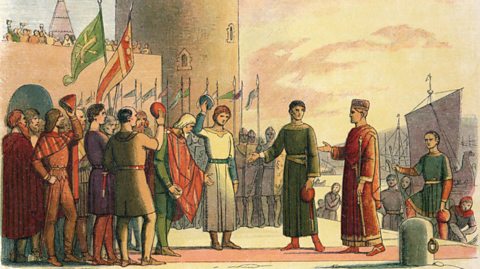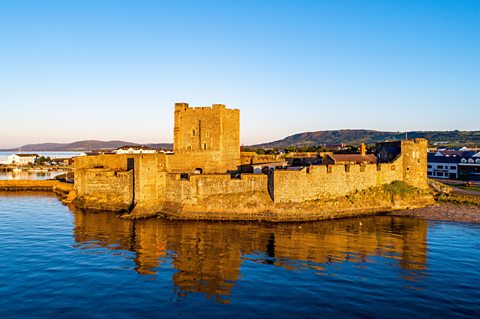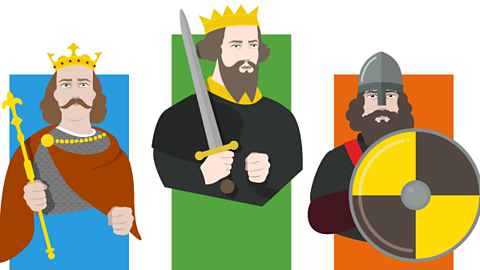Key points
- Most people in medieval society lived in villages, there were few large towns.
- The majority of people were peasants, who worked on the land.
- There were a range of jobs and trades in towns and villages, some quite similar to those people might have today.
Video about life in medieval England
Narrator: Most people in medieval England were farming peasants who lived in villages in the countryside. They had a hard life working all day on farms owned by nobles. By the 12th century this was changing. New towns developed around religious buildings, castles or trade routes. These towns were crowded, noisy and smelly. At dawn, a bell would ring to begin the day. Townspeople would attend their first religious mass of the day.
Towns were not healthy places to live. Although housing did improve during the period, there was no sewage system. So people discarded their waste in the streets or local rivers. People often shared their homes with their livestock, but none of these animals were house-trained. The town was run by powerful people such as merchants and lords, while the crafts workers and traders made their living in the bustling markets.
Crime was common in towns. If someone was accused of a crime such as stealing, one of the ways they might have to prove their innocence was through a trial by boiling water. The accused would have to pick up a stone from a pot of boiling water and people believed that if the person was innocent, God would heal the wounds within three days. If not, the person was guilty. The city gates were shut at dusk and the bell was rung for curfew. A night watchman would patrol the streets to look out for criminals or wild animals to keep townspeople safe.
Life in medieval villages
In medieval society, most people lived in villages and most of the population were peasants.
villeinsPeasants who were at the bottom of the feudal system. They worked and lived in land owned by a lord and were not allowed to leave without the lord’s permission. were peasants who were legally tied to land owned by a local lord. If they wanted to move, or even get married, they needed the permission of the lord first. In return for being allowed to farm the land they lived on, villeins had to give some of the food they grew each year to the lord. Villeins worked on strips of land, spread out in different fields across the village. Life could be hard; if crops failed to produce enough food, people faced starvation.
Some peasants were called freemenFreemen were a minority of peasants who had the right to move around the country and work on different pieces of land.. These peasants were able to move round from one village to another and did not have the same restrictions on them as villeins did.
Peasants' everyday life
Peasant homes were small, often just made up of one room. A peasant's hut was made of wattleA framework for a wall or fence made from woven twigs. and daubPlaster, clay, or another substance used for coating a surface, especially when mixed with straw., with a thatchA roof covering made of straw. roof but no windows. Inside the hut, a third of the area was penned off for the animals, which lived in the hut with the family. A fire burned in a hearth in the centre of the hut, so the air was permanently eye-wateringly smoky. Furniture was maybe a couple of stools, a trunk for bedding, and a few cooking pots.
Women in peasant families learnt to spin wool from an early age, using wooden wheels to make clothes.
Children spent most of their time helping their parents with day-to-day activities. Rather than going to school, they worked on jobs in the house, looked after animals and helped grow food.
Peasants also had to pay a tithePeasants had to give 10 per cent of what they produced on their land to the church. to the Church. A tithe was 10% of what they produced on their land. The Church was central to medieval life. People would attend services there every Sunday, and it would host marriages, christenings and funerals.
What challenges did a peasant face?
Peasants in medieval England were incredibly poor. Their main aim was to grow enough food to survive. This meant they often had to work long hours and their lives could depend on whether or not they grew enough food.
A peasant’s year would be based around farming and the seasons. In spring they would plough the land and sow seeds followed by tending to crops in the summer and harvesting them in the autumn.
Food supplies would be at their lowest in spring, as the stocks from the autumn harvest would start to run out.
Life in medieval towns
There were not many towns in medieval England, and those that existed were small by modern standards. London was the largest with a population of 10,000 and Winchester the second largest with 6,000 people. The Domesday BookThe Domesday Book was a survey of England to establish what every person owned. This helped William establish control over England and raise taxes. gives some idea about what life in towns was like.
There were many skilled craftsmen working in towns, such as carpenters, blacksmiths and tailors. Trade was a key part of town life, with goods such as iron, wool, salt and agricultural products being commonly bought and sold. Coastal towns would trade with other countries.
Some women were able to work as shopkeepers, cloth-sellers or run pubs, but these opportunities were very limited. Similar to villages, women were also expected to work in the home, cleaning and looking after their family.
Towns were often unhygienic because of the larger populations and the lack of proper sanitationAccessibility of clean drinking water and hygienic waste disposal.. Modern toilets and plumbing were a long way in the future and waste was thrown into the streets. Animals such as pigs and sheep roamed and butchers often threw waste meat into the street or river. These unsanitary conditions contributed to the spread of diseases, such as the Black Death.

Life in medieval castles
Following the Norman ConquestThe invasion and takeover of England by William of Normandy, or ‘William the Conqueror.’, castles were built across England to provide protection for William’s soldiers and serve as a warning to local populations who may have been angry about their presence. Wooden Motte-and-baileyA type of castle. Built on a small hill (motte) with a courtyard and enclosed farmland and houses at the bottom (bailey). castles were replaced over time with imposing stone castles, normally built on high ground overlooking a town.
Nobles who lived in castles would hold feasts in the Great Hall, often serving animals that had been hunted in nearby woods such as deer and boar. There would be a number of people who worked and lived in a castle, including servants, cooks and soldiers.
Hierarchy in medieval society
There was a clear hierarchyAn order of importance, from highest to lowest. In the feudal system, the king was at the top and peasants were at the bottom. in medieval society, often called the feudal system.
The king was at the top, followed by the nobilityMembers of the ruling class, just below the king in the feudal system. which included lords and members of the clergyReligious leaders in the church such as priests or bishops.. Below the nobility were knights, and then peasants. Freemen were peasants who were allowed to move around and had slightly more rights than villeins, who were legally tied to a specific piece of land.
As you go down the hierarchy system, the groups of people get larger, meaning that a small number of people, like the king and nobility, had control over a large number of people in the country.
Activity - Put these groups of people into the right order
Law and order in medieval society
In the medieval period, there was no organised police force and most law enforcement was organised by local people. In some areas, every male over the age of 12 had to join a group called a tithingA group of 10 people who were expected to maintain law and order within their group., and they had to make sure no one else in the group committed a crime. If someone was the victim of a crime, they had to raise the ‘hue and cry’, meaning other villagers had to come to help find the criminal.
Some areas had watchmen or constables who would patrol the area to prevent crimes. Most minor crimes were dealt with by the local lord. A judge, who was appointed by the king, travelled to each county to deal with serious crimes.
If a jury couldn't decide if a person was innocent or guilty, there was the option of trial by ordeal. This is where people were subjected to painful tasks, such as:
- Walking on hot coals
- Putting your hand in boiling water to retrieve a stone
- Holding a red-hot iron
If your wounds healed cleanly after three days, then you were considered to be innocent in the eyes of God. If not, you were considered guilty and would be punished accordingly. Punishments included being put in the stocks, fines, or even death for more serious crimes.
Education in medieval society
Some children went to school to learn to read and write, but most didn't. Schools were expensive and usually located in towns. Children from wealthy families may have had a tutor or attended a grammar school, but the cost of schooling meant that most children could not afford to go. There were also schools in monasteryBuildings lived in by a community of monks who live under religious vows., but places often went to children who were to become monks.
Instead of formal schooling, many medieval children learned how to farm, grow food and tend to animals. Some also learned a trade and perhaps became an apprentice to a local craftsperson like a carpenter or a tailor.
Test your knowledge
Play the History Detectives game! gamePlay the History Detectives game!
Analyse and evaluate evidence to uncover some of history’s burning questions in this game.

More on The Normans
Find out more by working through a topic
- count4 of 6

- count5 of 6

- count6 of 6

- count1 of 6
